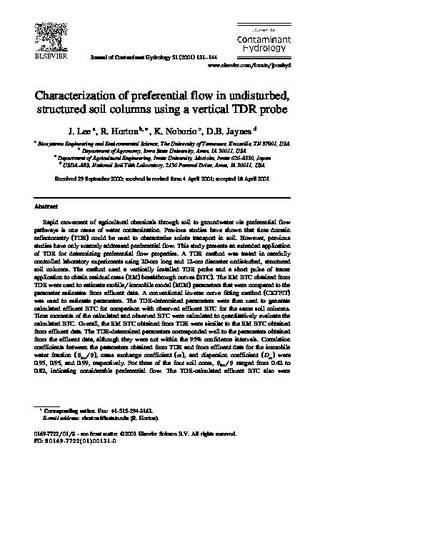
Rapid movement of agricultural chemicals through soil to groundwater via preferential flow pathways is one cause of water contamination. Previous studies have shown that time domain reflectometry (TDR) could be used to characterize solute transport in soil. However, previous studies have only scarcely addressed preferential flow. This study presents an extended application of TDR for determining preferential flow properties. A TDR method was tested in carefully controlled laboratory experiments using 20-cm long and 12-cm diameter undisturbed, structured soil columns. The method used a vertically installed TDR probe and a short pulse of tracer application to obtain residual mass (RM) breakthrough curves (BTC). The RM BTC obtained from TDR were used to estimate mobile/immobile model (MIM) parameters that were compared to the parameter estimates from effluent data. A conventional inverse curve fitting method (CXTFIT) was used to estimate parameters. The TDR-determined parameters were then used to generate calculated effluent BTC for comparison with observed effluent BTC for the same soil columns. Time moments of the calculated and observed BTC were calculated to quantitatively evaluate the calculated BTC. Overall, the RM BTC obtained from TDR were similar to the RM BTC obtained from effluent data. The TDR-determined parameters corresponded well to the parameters obtained from the effluent data, although they were not within the 95% confidence intervals. Correlation coefficients between the parameters obtained from TDR and from effluent data for the immobile water fraction (θim/θ), mass exchange coefficient (α), and dispersion coefficient (Dm) were 0.95, 0.95, and 0.99, respectively. For three of the four soil cores, θim/θ ranged from 0.42 to 0.82, indicating considerable preferential flow. The TDR-calculated effluent BTC also were similar to the observed effluent BTC having an average coefficient of determination of 0.94. Time moments obtained from calculated BTC were representative of those obtained from observed BTC. The vertical TDR probe method was simple and minimally destructive and provided representative preferential flow properties that enabled the characterization of solute transport in soil.
Available at: http://works.bepress.com/robert-horton/95/

This article is published as Lee, J., R. Horton, K. Noborio, and D. B. Jaynes. "Characterization of preferential flow in undisturbed, structured soil columns using a vertical TDR probe." Journal of contaminant hydrology 51, no. 3 (2001): 131-144. doi: 10.1016/S0169-7722(01)00131-0. Posted with permission.